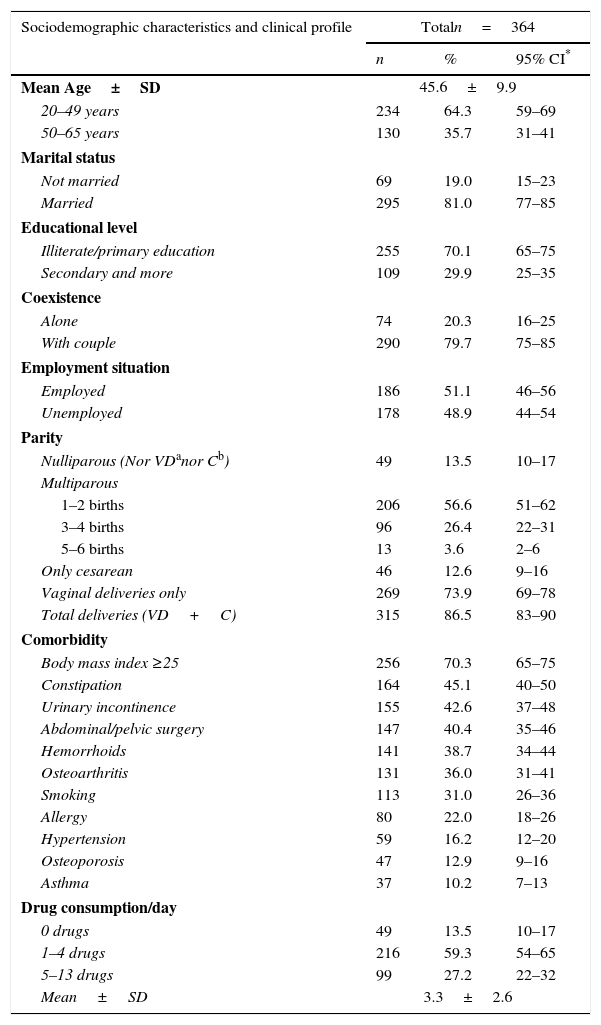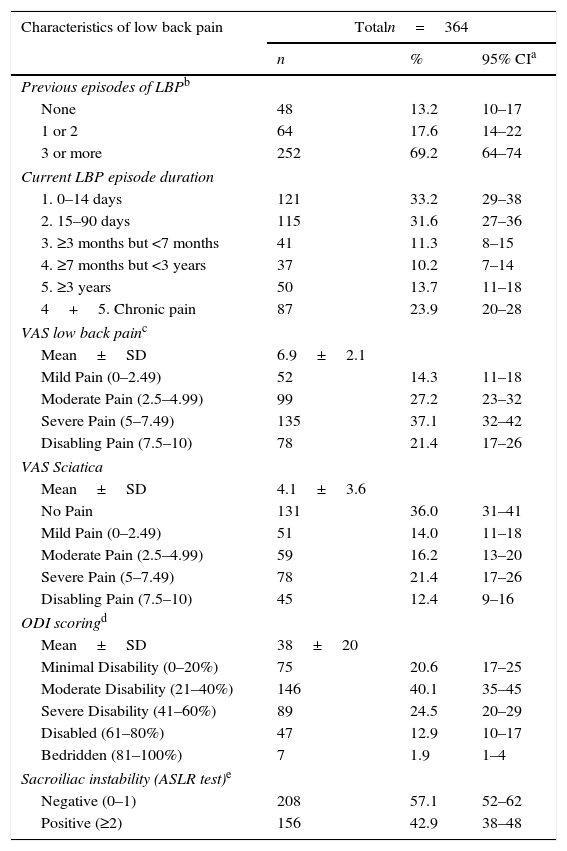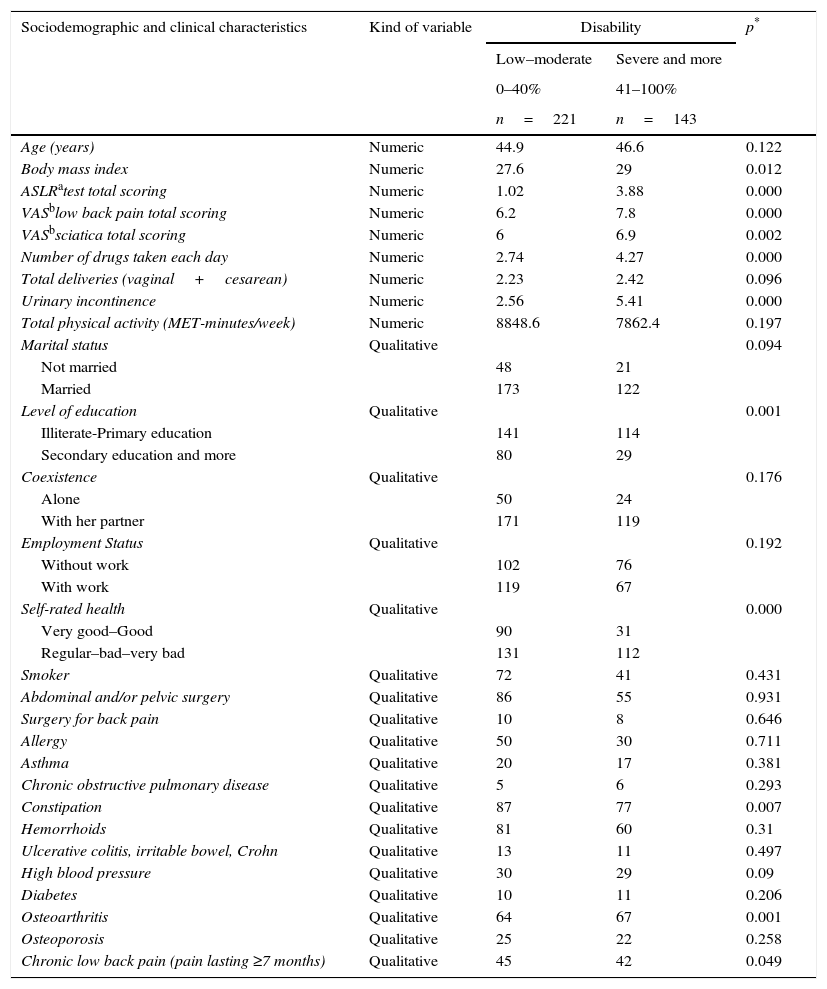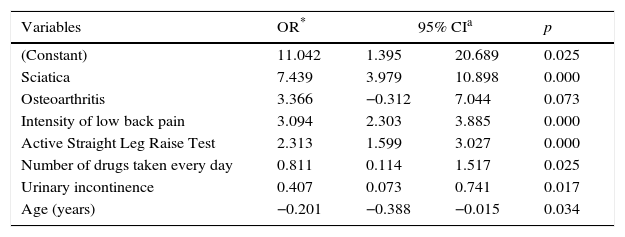To identify sociodemographic, clinic profile and factors associated with low back pain (LBP) in women who consult for this reason.
MethodsCross-sectional study carried 28 October 2010 and 29 April 2011 out in 2 primary care centers in Cordoba and 1 private center in Madrid. A total of 364 women participated, with ages 20–65 years (of the 466 women contacted, 33 were excluded for inability to contact them, 29 did not attend the interview and 40 refused to participate). These women had consulted because of back pain located between the twelfth rib and the gluteal fold, with or without pain that went down the leg. They were interviewed by means of a questionnaire and the performance test was evaluated by Active Straight Leg Raise (ASLR) test.
Outcome measuresPresence and intensity of LBP, Oswestry Disability Index (ODI), number of births, urinary incontinence (UI), ASLR test, digestive, respiratory and osteoarticular comorbidity, diabetes, high blood pressure, drugs, physical activity and sociodemographic data.
A descriptive and multivariate statistical analysis was performed.
ResultsMean age 46 years, 24% with chronic pain, 43% with UI and positive ASLR and 39% severe disability grade (ODI>40%). In the multivariate analysis the variables associated with severe disability caused by LBP were sciatica (OR 7.439; 95% CI: 3.979–10.898), osteoarthritis (OR 3.366; 95% CI: −0.312 to 7.044), LBP intensity (OR 3.094; 95% CI: 2.303–3.885), ASLR+ (OR 2.313; 95% CI: 1.599–3.027), increased use of drugs (OR 0.811; 95% CI: 0.114–1.517) and IU (OR 0.407; 95% CI: 0.073–0.741).
Conclusions39% of women have severe incapacity that is related to the presence of sciatica, osteoarthritis, LBP intensity, ASLR+, drugs and IU.
Identificar las características sociodemográficas y clínicas y los factores asociados al dolor lumbar (LBP) en mujeres que consultan por este motivo.
MétodosEstudio transversal realizado en 2 centros de atención primaria de Córdoba y un centro médico privado en Madrid. Participaron 364 mujeres (de 466 contactadas, 33 fueron excluidas por imposible contacto, 29 no acudieron a la entrevista y 40 rechazaron participar) que consultaron por dolor de espalda localizado entre la duodécima costilla y el pliegue glúteo, con o sin dolor irradiado a la pierna. Se realizó entrevista con cuestionario y se valoró la ejecución del test de elevación activa de la pierna extendida (test ASLR).
Medidas de resultado: Presencia e intensidad del LBP, Índice de Discapacidad de Oswestry (ODI), número de partos, incontinencia urinaria (IU), test ASLR, comorbilidad digestiva, respiratoria y osteoarticular, diabetes, hipertensión, fármacos, actividad física y datos sociodemográficos.
Análisis estadístico descriptivo y multivariante.
ResultadosEdad media 46 años, el 24% con dolor crónico, el 43% con IU y ASLR positivo y el 39% con una incapacidad severa (ODI >40%). Las variables asociadas en el análisis multivariante con incapacidad severa causada por LBP son ciática (OR = 7,439; IC del 95%: 3,979–10,898), artrosis (OR = 3,366; IC del 95%: −0,312–7,044), intensidad del dolor (OR = 3,094; IC del 95%: 2,303–3,885), positividad test ASLR (OR = 2,313; IC del 95%: 1,599–3,027), mayor consumo de fármacos (OR = 0,811; IC del 95%: 0,114–1,517) e IU (OR = 0,407; IC del 95%: 0,073–0,741).
ConclusionesEl 39% de las mujeres tiene una incapacidad severa que está relacionada con ciática, artrosis, intensidad del dolor, test ASLR+, fármacos e IU.
Artículo
Si ya tiene sus datos de acceso, clique aquí.
Si olvidó su clave de acceso puede recuperarla clicando aquí y seleccionando la opción "He olvidado mi contraseña".Comprando el artículo el PDF del mismo podrá ser descargado
Precio 19,34 €
Comprar ahora













